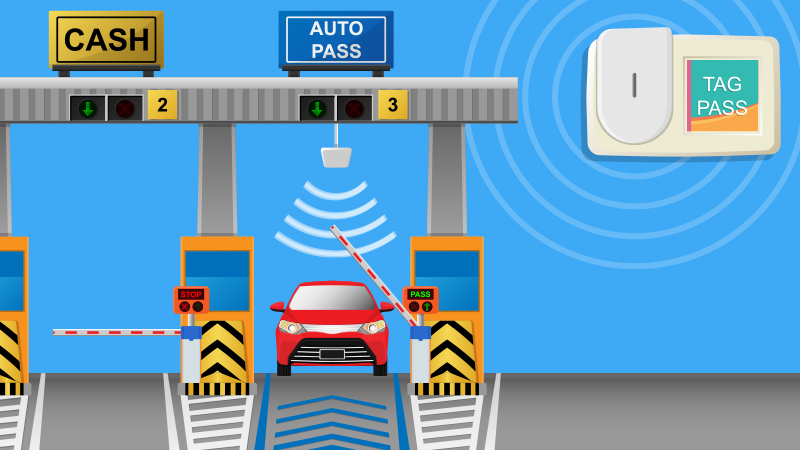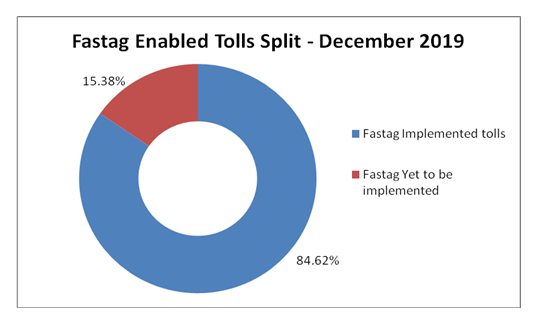
Impact of FASTag on the Indian Road Freight Industry


FASTag is a radio frequency identification-enabled system that facilitates toll collection from all four-wheeler and above vehicles at toll plazas. This government initiative was introduced in response to an indefinite strike called by the All India Motor Transport Congress in October 2015 against the toll collection and delays at toll plazas. This system has taken giant strides since 2016 with respect to its implementation, which was made mandatory in December 2019.
FASTag has received mix response throughout the country. Different stakeholders have different opinions concerning FASTag adoption. This article discusses the current state of its implementation as of December 2019, practical adoption challenges faced by different stakeholders, cost benefits that shippers and trucking companies can achieve through the use of FASTag, and the market outlook of FASTag in India.
Highlights
-
Current state of FASTag Implementation
-
Practical challenges and solutions surrounding FASTag implementation
-
Carriers
-
Shippers
-
-
Key Recommendations for Better FASTag Use
-
Cost benefits of FASTag
-
Market Outlook of FASTag
Current State of FASTag Implementation
FASTag adoption was made mandatory from Dec. 15, 2019 and later its deadline was extended to Jan. 15, 2020. Of the 520 toll plazas in India, 440 toll plazas are FASTag-enabled, as of December 2019. Punjab and Haryana have been ahead in terms of FASTag usage; FASTag transactions account for 23 percent of the total toll volume in these two states, together comprising 38 toll plazas and 444 lanes. Delhi’s NCR region has also been leading with FASTag adoption and implementation. In September 2019, 3.97 lakh vehicles made cash payments at toll plazas, while 1.25 lakh used FASTag.
Across the country, 72 lakh vehicles have already been affixed with FASTag; the governement expects about 11 lakh FASTag transactions per day, generating a projected revenue of 25–30 million rupees and a toll volume of 40 percent. All toll plazas implemented FASTag from January 2020.
Practical Challenges and Solutions Surrounding FASTag Implementation
Challenges for Carriers
-
Documentation Challenges for small-scale service providers: The Indian trucking market consists of small-scale trucking companies that own less than 20 trucks, but contribute to 90 percent of the market share; few of these trucking companies may face documentation issues when replacing their older trucks with Bharat Stage (BS)-VI emission control trucks.
-
Driving in the wrong lane: A truck driver who is unaware of the difference between a hybrid FASTag lane and a cash lane may enter a wrong lane and pay a double toll . In other words, current norms, as of Jan. 15, 2020, state that FASTag lanes must be used only by FASTag users, while normal cash lanes must be used by users paying cash. Cash users will pay double the amount as toll if they enter the FASTag lane.
-
Technology-based shortcomings: When a FASTag vehicle uses FASTag for paying the toll fee, the fee is automatically deducted from the user’s account after the vehicle crosses the toll plaza. Recent instances show the double as well as wrong deduction of cash. Especially, trucking companies located at a close proximity to a toll plaza get a toll discount because they frequently use that particular toll plaza. The government collects a minimum amount from these companies, instead of the actual amount, owing to their frequent use of the plaza. Currently, these trucks are paying double toll because they are spending on FASTag while paying a minimum premium.
-
Refund of the FASTag Cash: Although the FASTag wallet can be recharged electronically using Paytm and various channels of banks, the application for refunds must be sent manually to the authorities residing near the toll plazas.
-
Unexpected delays in toll plazas: Owing to the rapid pace of FASTag implementation, toll plazas are experiencing delays as new users are having trouble adapting to the new system. This scenario is expected to affect all toll users
-
Issues in Linking Bank accounts: Users have the option of linking their bank account to the FASTag app or recharging their FASTag wallet online. In the current scenario, carriers are hesitant to link bank accounts to FASTag wallets due to security reasons; they also feel that managing wallets manually, especially for national permits trucks, will be tedious as they pass through multiple tolls.
Solutions for Carriers
-
Carriers must educate the drivers about the different types of lanes, such as the cash and hybrid FASTag lanes; this can keep them from paying penalties or making double payments. Considering the lower literacy rate of Indian truck drivers, educating and training in this regard can prove to be useful.
-
Carriers must decide between using a FASTag wallet and linking the app with a bank account. While they can adopt both payment methods, they must learn to manage these payments and the wallet effectively. While a minimum balance of 100 rupees can be maintained in the wallet, it is advisable to have a minimum balance of 300-500 rupees to avoid trouble while paying tolls.
Challenges for Shippers
-
Anticipating General Delays: Shippers will also face time delays due to an inability to discriminate between toll users and FASTag users. Long haul shipments must be well-planned in order to achieve the desired transit time.
-
Higher Impact of Delays on Perishables and Over-dimensional Cargo Shipper: Transit delays heavily impact perishables and over-dimensional cargo. The state of perishable cargo undergoes a change over time, even when stored under refrigerated storage conditions, and hence perishable shippers must plan well to meet the desired transit time. Over-dimensional cargo shippers may not be allowed inside cities during certain time period, which can increase the transit time. This transit time will be further stretched due to FASTag implementation. This scenario may induce drivers to demand high wages and bonuses from shippers.
-
Carriers billing the penalties to Shippers: Carriers may include the FASTag penalties in the final freight bill. Carriers may not want to absorb the penalties owing to revenue loss on account of unfavorable market conditions.
Solutions for Shippers
-
Shippers must effectively manage the transit time through advance cargo planning in order to avoid any cargo delays. Perishable shippers should work with FASTag-enabled carriers in order to avoid any transit abnormalities.
-
Carriers should be given clear instructions and key performance indicators (KPIs) to avoid the penalties, which the carrier may bill to the shippers. Shippers should instruct carriers not to transfer the additional costs to the final freight bill.
Key Recommendations For Better FASTag Usage
-
Existing barriers: The government expects to bring down waiting time at toll plazas from 30-4 seconds to 8-15 seconds. However, this seems unlikely, given the existing barriers at the FASTag-enabled tolls and a low likelihood of the removal of these barriers in the near future. The government must take steps to remove the barriers after achieving a better adoption rate and swift FASTag transactions.
-
Lack of support personnel at tolls: Although the government has increased the number of personnel at toll plazas to respond to the FASTag queries of users, it is difficult for the existing personnel to handle the long list of queries. The government can appoint retired officers and part-time employees to respond to user queries until there is an improvement in the existing scenario.
- No free FASTag: Nitin Gadkari, the Minister for Road Transport and Highways of India and Shipping, had directed the National Highways Authority of India to provide free FASTag tokens until Dec. 15, 2019, but users were charged for getting a new FASTag. These charges comprised the cost of the FASTag, cashback on FASTag recharge, and minimum non-refundable premium. In order to promote the usage of FASTag, free FASTags can be issued in public interest.
Cost Benefits of Using FASTag
The government has announced cashback offers on toll fees for promoting the use of FASTag. A cashback of 2.5 percent has been introduced for using both the state and national highway toll plazas. These offers are valid until FY2019-20. However, based on the adoption rate of FASTag, cashback offers may be extended or new offers may be announced.
|
Origin |
Destination |
Distance |
Number of toll plazas |
Normal toll fees Collected |
Toll fees through FASTag |
Cost Savings from the use of FASTag |
|
Aurangabad |
Delhi |
1252 |
9 |
3590 |
3500 |
90 |
|
Aurangabad |
Nagpur |
475 |
10 |
1535 |
1497 |
38 |
|
Aurangabad |
Lucknow |
1203 |
21 |
5655 |
5514 |
141 |
|
Aurangabad |
Pune |
237 |
9 |
885 |
863 |
22 |
|
Aurangabad |
Goa |
645 |
12 |
1145 |
1116 |
29 |
|
Aurangabad |
Gwalior |
914 |
13 |
3565 |
3476 |
89 |
The above table considers cost savings in the case of 18 MT closed body trucks. Savings with respect to cost is minimal and is subject to change based on the distance, number of tolls, and the type of vehicle used.
Market Outlook For FASTag
-
FASTag will reduce time and congestions in toll plazas and reduce the use of cash. The government implemented FASTag 5 years back, which proved to be beneficial for a few large trucking companies using FASTag. Many reputed carriers in India have been using FASTag for the past few years. They have been successful in mitigating physical cash transactions and saving time at toll plazas. Although it will take some time to reap the benefits of FASTag implementation, its outlook is expected to be promising.
-
Shippers should pressurize trucking companies to use FASTag; this will help shippers to avail cashback offers on additional cargo volumes and save freight costs.
-
The lack of support personnel for addressing queries may hinder the achievement of objectives of FASTag. A solution to these issues will positively influence the toll users and, eventually, the adoption scenario.
-
Adequate support should be provided to toll users, such as quick refunds and quick issue of FASTag ID. Quicker grievance redressal can contribute toward gaining users’ trust and increasing the FASTag system’s reliability.
References
https://www.cnbc.com/2019/11/20/reuters-america-factbox-global-refiners-raise-cleaner-shipping-fuel-output-ahead-of-imo-2020.html https://www.tribuneindia.com/news/archive/FASTag-your-way-through-868442
https://economictimes.indiatimes.com/news/economy/infrastructure/FASTag-will-hasten-road-assets-sale-says-nhai/articleshow/72451743.cms
Related Insights:
View All
Get more stories like this
Subscirbe for more news,updates and insights from Beroe







